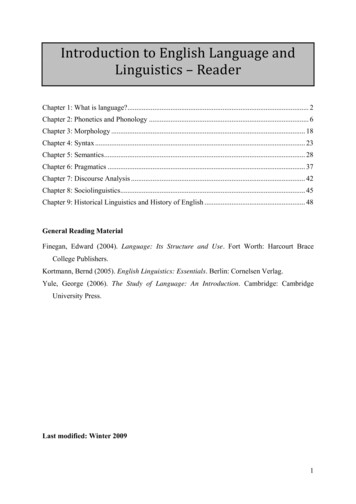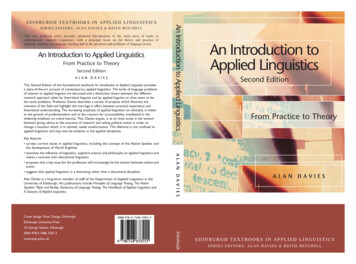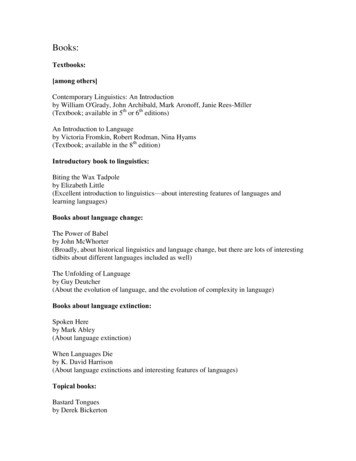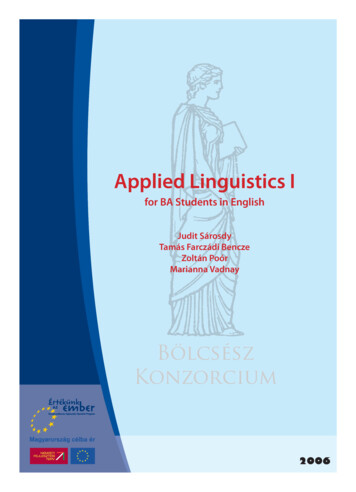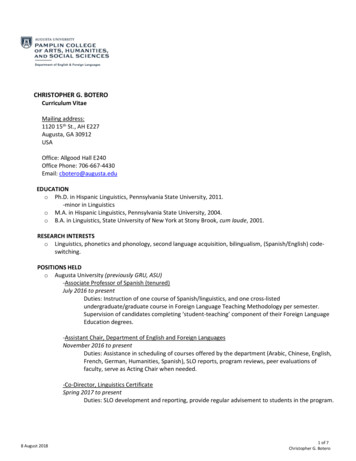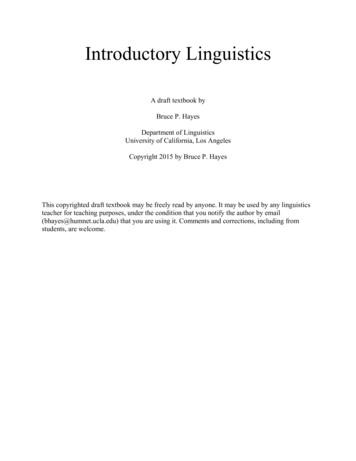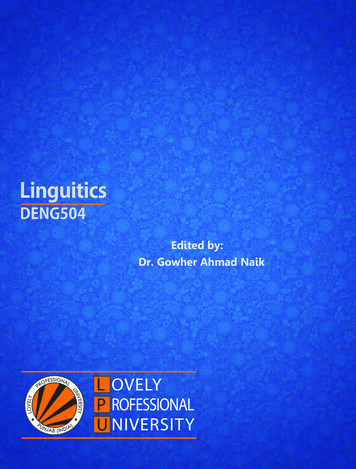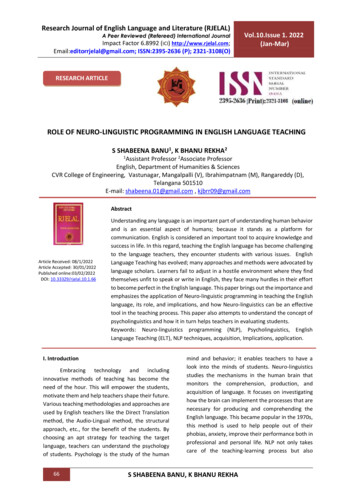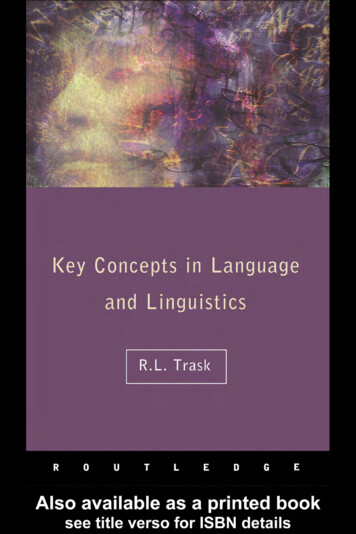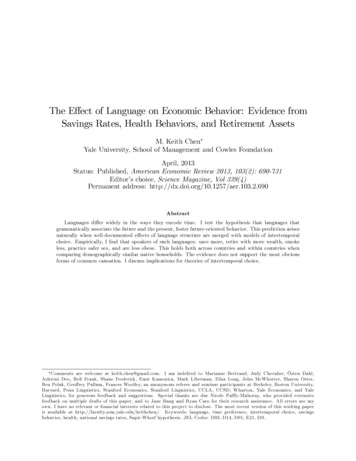
Transcription
International Journal on Studies in English Language and Literature (IJSELL)Volume 2, Issue 8, August 2014, PP 116-130ISSN 2347-3126 (Print) & ISSN 2347-3134 (Online)www.arcjournals.orgStructural Linguistics and its Implication to LanguageTeachingNoer Doddy Irmawati, Dr. M. HumGraduate Program of English EducationAhmad Dahlan University YogyakartaAbstract: Structural Linguistics is an approach to linguistics and is a part of overall approach ofstructuralism. It is stressed examining language as a static system of interconnected units. StructuralLinguistics involves collecting a corpus of utterances and then attempting to classify all the elements of thecorpus at their different levels: the phonemes, morphemes, lexical categories, noun phrases, verb phrases,and sentence types (Wikipedia).Language Learning needs to apply language education because it is the teaching and learning of foreign orsecond language. Language education is also a branch of applied linguistics that can be applied to theteaching of language. In teaching language, the teaching learning strategies are also be applied becausethey have attracted increasing focus as a way of understanding the process of language acquisition(Wikipedia).Structural linguistics has its implication to language teaching, such as: there is a key concept that must beoperated; language learning must be viewed in one contex and background; language forms as signsystem; there is one good method in teaching language; linguistics finding of structuralism model can beapplied in teaching language; language has rule, pattern, and system that must be followed; and structurallinguitics can be used as an alternative method in language teaching.Keywords: Structural, Linguistics, Implication, Language, Teaching1. INTRODUCTIONLinguistics is a set of knowledge which is gained by the application of scientific methods to thestudy of language phenomena. These limits are stretched a line of clear binder between scientificlinguistic study and the study of language that is a non-scientific (Hughes, 1968: 11). Cook saidthat linguistics is the scientific study of language (1971- 1).Linguistic is the science of language. In Indonesian language, Linguistic is the name of science,and the adjective form is "linguistic" (Verhaar, 2001: 3). Linguistic is often called "generallinguistics" means that the science of linguistic not only investigates only one language (such asEnglish or Indonesian), but it involves linguistics‟ language in general.Linguistics‟ Science is divided into some varying subordinate areas, for example, there areanthropological linguistics, there are sociological linguistics, commonly called sociolinguistics,and while there is now a computational linguistic. The all subordinate fields presuppose theexistence of underlying linguistic knowledge. The underlying field is the field that involvescertain basic structures, namely the structure of language sound, this field is called "phonetics"and "phonology", the words‟ structure is called "morphology", the structure between words insentences is called "syntactic", the study of meaning is called “semantic”, all aboutcommunication strategy between internal people is called “parole”, or the use of language, andlanguage is also concerned with the relationship of speech to talk about what, is called"pragmatic".There are three definitions of linguistic; the first is “the science of language, such as its structure,acquisition, relationship to other forms of communication” (Hornby, 1980: 494). It means thatlanguage science, for example its structure, its mastering, its relation to the forms of othercommunication. The second, “the study of human speech including units, nature, structure andmodification of language” (Webster, 1981: 664) that is the study of human talk consists of its ARCPage 116
Noer Doddy Irmawati, Dr. M.Humunity, its princip, its character, its structure, and language change. The third definition is “thescientific study of language” (Ronald Wardhaugh, 1972: 213).Verhaar in his writing concluded that linguistics is a science that has a formal object spoken andwritten language, which has the characteristics of differentciate, the terms: systematic, rational,empirical, generally, as a divider structure differentciate of fact, the parts and the rules oflanguage (2001: 58).Linguistics is described as the science and language as an object (Verhaar, 2001: 58). In generallinguistics commonly defined as the science of language or science that takes language as anobject of study. If it is said that the linguistic object of the study is language, while language itselfis a phenomenon that is presented in all the activities of human life, then Linguistic becomes avery broad field of study. Thus the knowledge and mastery of the field of linguistics have a lot ofbenefits for language teaching.Based on the description above and pay attention to the title of this paper, the writer will discussseveral subjects, among others: what structural linguistics; what was the language; what is meantby language teaching; what are the benefits of linguistics in language teaching; how therelationship between linguistics and language teaching.2. STRUCTURAL LINGUISTICSThe flow of Structural Linguistics was born in the early twentieth century or precisely in the yearof 1916. This year becoming the birth of monumental structural flow, because in that year a bookentitled “Course de Linguistique Generale” by de Saussure was published, which contains themain points of the structural theory as well as the thoughts of modern linguistics. Before thetheory emerged, the world of linguistics has not moved from the traditional theory. The presenceof de Saussure‟s works really perceived as a revolution. Therefore, it is not surprising that deSaussure given the title as the "Father of Structuralism" and at the same time as the "Father ofModern Linguistics".Before, this structural flow is putting form and meaning in a balanced position, but in itsdevelopment becoming a variety of versions. There is a version that is more emphasis on theterms of shape and some versions that are more emphasis on the meaning of terms.The characteristics of structural flow according to Soeparno (2002: 48-51) can be cited as follows:1. Based on the adherence to BehavioristicIn line with the understanding of behaviorism, language processes as other behavior, is astimulus-response process. Every human being is basically speaking as the response of a stimulus.Stimulus sometimes is in the form of speech, sometimes is in the form of sign with bodymovement (gesture), and sometimes is in the form of situation.2. Language is in the Form of SpeechThis characteristic indicates that only thing in the form of speech can be called language.The forms of embodiments in addition to speech cannot be classified in terms of theactual language, as well as writing. In language teaching, structural theory spawned directmethod with the oral approach.3. Language is in the form of Sign System ( Signifie and Signifiant)Substantially language is a sign system. The marking system is arbitrary andconventional. Sign system in language is in the form of two sides, the first side is signifie,while the other side is signifiant. Arbitrary is the characteristic of its sign which isfree/rejoin.Nevertheless, its freely is limited by a convention or agreement among the users.4. Language is Habitual FactorStructuralists apply the method in learning language that became known by drill and practicemethods, that is a form of method that provides continuous trining and repeatedly so finallyforming a habit. Unfortunately, such a form of exercise is very drab/boring.International Journal on Studies in English Language and Literature (IJSELL)Page 117
Structural Linguistics and its Implication to Language Teaching5. Grammatical Based on GeneralityThe form and structure of the language that has been used or that are already commonly usedalone is considered as a grammatical form. The forms that the rule is actually true but notcommonly used or has not been forced to be expressed as a general form that is not grammatical.Thus the standard which is used to establish whether a grammatical level of language is standardgenerality, not standard rules or norms.6. Grammatical Levels are Enforced NeatlyGrammatical levels are enforced in the range from the lowest level (phoneme) to the highest level(sentence). The range of grammatical levels is morphemes, words, phrases, clauses, andsentences. Above the level of the sentence has not been reached by this flow. Morpheme andword are the coverage of the field of morphology, while the phrases, clauses and sentences aresyntactically field coverage. Morphology and syntax are two areas that stand alone, although stillkeep in touch with the field of morphosyntax.7. Analysis Pressure is in the Field of MorphologyStructuralist emphasizes morphological analysis. This does not mean that other areas are ignored.This word pattern analysis is then used as a structural analysis model, it is said by Eugine Nida inhis book Morphology (1982).8. Language is a Row of Syntaxmatic and ParadigmaticA. Syntaxmatic RowsThis row is a horizontal row of elements. This row is happen in all levels. Segmental phonemes inthe form of syntaxmatic to form a larger structure such as syllables and morphemes. Such prosedeis called phonotactic. Morphemes in the form of syntaxmatic form a larger stucture that is calledword. This kind of prosede is called morphological prosede. The words in the form ofsyntaxmatic form the larger structure which is called phrase. Then phrases become clause.Finally, the clauses form sentences. The three prosedes which are mentioned latter are calledsyntactically prosede.B. Rows of ParadigmaticWhat is meant by the paradigmatic row is a row of similar structure vertically.For example: Spanish languageEnglish languageElgatoestaestaakithe cat is hereUngatoestaakithere is a cat hereElgatoestaenfermothe cat is illThe usefulness of this paradigmatic row is to find or define the elements of language. From theparadigmatic row above can be determined that the language element of gato means „cat‟. Thisparadigmatic also applies to any level of element.9. Language Analysis Based on DescriptiveAccording to the structural analysis flow, language should be based on original reality. Thelanguage data that are analyzed is only the data at the time the research is done. Their motto:describe the facts, all the facts, and nothing but the facts. The historical elements are totallyignored. This kind of analysis is started from a synchronic approach.10. Language Structure Analysis Based on Direct ElementThe definition of a direct element is the element that is one step lowerfrom its structure. Thisdirect element is usually also referred to as immediate constituents abbreviated by: “IcS” or “thenearest lower element”. In structural theory there are several structural analysis model of directelement, such as Nida‟s model, Hockett‟s model, Nelson‟s model, and Wells‟ model.International Journal on Studies in English Language and Literature (IJSELL)Page 118
Noer Doddy Irmawati, Dr. M.HumNida‟s Model:abeautifulgirlHockett‟s Model:abeautifulgirlbeautiful girlNelson‟s Model:Wells‟ Model:abeautiful girl(a)(beautiful)a(girl)beautifulgirlLanguage expert who follow structural flow, among others: Ferdinand de Saussure, LeonardBloomfield, Zelling Harris, Ch. C. Fries, Eduard Sapir, N.S. Trubetzkoy, William FrancisMackey, Roman Jacobson, Martin Joos, and others.According to them, special features of a language will not be separated from the discussion.Special features of language are called the type of language or language typology. There are threekinds of language typology, namely: 1) the typology of genealogical; 2) typology of geographicor typology of areas; and 3) structural typology.Structural typology uses language structure criteria that include morphological structure, thestructure of morphosyntax, fraseologis structure, and the structure of the clause.1) The Typology of Morphological StructureBased on the differences of morphological structure, there are four language types, namely:a) The agglutinative, that the structure was formed by the merger of the principal elements andadditional elements, basic elements and basic elements, or the repetition of basic elements.Thus, there are three types of morphological prosede on this type of language, namely:affixation, compounding, and repetition. Languages that belonging to this type are, amongothers: the Java language, Malay language, and Sunda language.b) Flexion, the structure of its word is formed by changing the form of the word. There are twokinds of changing of the form of word in this type of language, such as declination andconjunction. Declination is the change in word form caused by the differences of type,number, and case. Conjunction is the change of word form caused by the change of interest,number, time, and word. Language that has pure flexion type, for example: Arabic language,Sanskrit language, and Latin language.c) Flexso- agglutinative, this type is a summary of two types, namely the types of flexion andagglutinative. The part of morphological prosede of the language that has this type follows thelanguage patterns of flexion and partly to follow the patterns of the language that hasagglutinative type. One of the languages that is very apparent to flexso agglutinative type isEnglish.d) Isolative/Isolation, this type of language is not experiencing morphological prosede or inother words there is no word formation. All words have never experienced changes andadditions to the segmental form. Distinctive elements that can be found here is the change andthe difference of tone. Therefore, this type of language is often also called “Tonis” language.Languages belonging to this group are Thai, Vietnamese, and Chinese groups such asMandarin, Shanghai, Kantong, and others.2) The Structural Typology of MorphosyntaxInternational Journal on Studies in English Language and Literature (IJSELL)Page 119
Structural Linguistics and its Implication to Language TeachingBased on its morphosyntax structure, there are three kinds of languages, namely:a) Analytical Language TypeIn this type of language, each word has a single concept and does not consist of a combinationof concepts. The formation of phrases, clauses, or sentences is done by combining the monoconcept words into larger structures with poly-concept. In other words, the type of language isthe language of this analytical structure consists of separated elements. The language whichbelongs to this type is: Indonesian, Javanese, Sundanese, Malagasy, Tagalog, Bugis, Chineselanguages and so on.b) Synthetical Language TypeThe language with this type has a characteristic that the form of language had conceived theconcept of the meaning of syntax and also has a syntactical relationships. The language thatbelong to this typeis Arabic, Sanskrit, Latin, and Biak languages.c) Synthetical Language TypeThe language that has this type has a characteristic that the form of language had conceivedthe concept of the meaning of syntax and also has a syntaxtical relationships. The languagethat belongs to this type, such as Arabic, Sanskrit, Latin, and Biak languages.d) Polysynthetical Language TypeThis type of language is almost the same image with the type of synthetical language that ismore complex. A particular form of words is not just a series of simple clause or clausesroots, but it is a sentence. The language which belongs to this type is Eskimo and somelanguages in North American Indians.3) Phraseologies Structure TypologyBased on the differences in the structure of the phrase, there are two types of languages, thelanguage of central-attribute and the language that has an attribute-central, or traditionally can becalled language that has a type of being explained and explaining types (D-M), such as: Arabic,Javanese, and Sundanese. Besides language that explaining and explained type (M-D), such asEnglish, Dutch, German, and others.4) Clause Structure TypologyBased on the structure of the clause, there are two kinds of language that have Verb-Object type(V-O) and language that has Object-Verb type (O-V). For example: Sanskrit, Nepal languagesand so on.C. The Nature and the Function of LanguagesLanguage plays an important role in our daily lives. In everyday tasks, the language teacher mustunderstand completely that the ultimate goal of teaching language is to have students masteringthe skill of language, such as: speaking skilled, listening skilled, reading skilled, and writingskilled.Language has the main characteristic of which is the nature of language. By knowing the variousbasic principles of the language, then the teacher has had a major capital in performing his dailyduties. Languages also have diverse functions. Knowledge of the basic principles and variousfunctions of the language that absolutely must be had by the teachers who always deal with thestudents.Important matters relating to the nature of language and language function, which should beknown and understood by language teachers, will be discussed below:1. The nature of languageTalking about the nature of language, Paul S. Anderson (1972: 35-36) argues that there are eightbasic principles of the language, namely:a. Language is a systemb. Language is speech soundInternational Journal on Studies in English Language and Literature (IJSELL)Page 120
Noer Doddy Irmawati, Dr. M.Humc. Language is composed of symbols (arbitrary symbols)d. Each language is unique and typicale. Language is built from habitf.Language is a communication toolg. Language is closely linked to the culture it is locatedh. Language is always changingAnother expert H. Douglas Brown (2001: 5), after reviewing the boundaries of language from sixsources, summarizes about the language as follows:a. Language is a system that is systematic, perhaps also for generative systemsb. Language is a set of symbols (arbitrary symbolsc. The symbols are primarily vocal, but may also be visuallyd. The symbols contain the conventional meaninge. Language is used as a communication toolf.Language operates in a speech community or cultureg. Language is essentially human, although probably not limited to humans onlyh. Language is acquired by all people/nation in a way that is almost the same; language andlearning language have the universal characteristics.Anderson and Brown‟s opinion that have been described above can be clearly seen the differencesor similarities through the following figure (figure 1).The outer circle contains the opinion of Anderson, and the inner circle exploresthe idea ofBrown. From both experts and both sources, similar opinion and ideas about language can beseen. Only the way to perform the ideas using different words.Anderson’s OpinionHabitChangingComNature ToolsBrown’sOpinionRelate toCultureSystemHumanEight om CommunicationToolsConventionalMeaningUnique, ational Journal on Studies in English Language and Literature (IJSELL)Page 121
Structural Linguistics and its Implication to Language Teaching2. The Function of LanguageIt is a fact that human beings use language as a vital means of communication in their life.Language is had by human beings. Language is one of the main distinguishing features of humanbeings than the other living beings in this world. Every member of the community involved inlinguistic communication; on the one hand, he acted as a speaker and on the other hand as anobserver/a listener. In smooth communication, the process of changing from speaker toobserver/listener, from observer/listener to speaker becomes observer speaker is so fast, feels likea normal and natural event, which for the average person it is no need to be disputed, analyzed,and studied.Another case for the experts in the field of linguistics and language teaching. If “a languageevent” between the” speaker” and the “observer/listener” is analyzed, the transition can be seenlike in the following figure (figure 2 DecodingPhonationAuditionsTRANSITIONFigure 2. A Language Event (Brooks, 1964: 4)Language has an important function for human beings, the most important is the function ofcommunication. Talking about the function of language, the name of Halliday should bediscussed. From his book entitled “Exploration in the Development of Language” (1975) there areseven functions of language as his finding. They are:a. The Instrumental FunctionThis fungtion serves the process of environment, caused specific events happen.b. The Regulatory FunctionThis function acts to supervise and control every event that is happened. The regulationfunction or this management acts to conduct and control other people.c. The Representational FunctionIt is the use of language to make statements, to tell the facts and knowledge, to explain or toreport, to represent the reality fact, as an example is the following statement: “the sun is hot”.d. The Interactional FunctionThe task is to stabilize and to strengthen the status of the social communication happen. Thesuccess of interactional communication is caused by enough knowledge of “slang”, “jargon”,“funny story”, “folklore”, “common etique”, and “culture”. “the way to perform”, etc.e. The Personal FunctionIt gives the opportunity to speakers in expressing their feeling of own emotion, egoism, anddeep reaction. Ones personality usually signed by its personal of language function incommunication. In the nature of personal language, it is clear that the awareness, feeling, andculture play the interaction together with the deepest way that do not researched yet.International Journal on Studies in English Language and Literature (IJSELL)Page 122
Noer Doddy Irmawati, Dr. M.Humf.The Heuristic FunctionIt includes the use of language to get science, to learn all about the environment. Heuristicfunction is often told in the form of question that need the answer. Research, willing to know,is the form of heuristic method to find the reality representation of others.g. The Imaginative FunctionIt serves the creation of systems or ideas that have imaginative characteristics. Telling thestory, reading story, writing novels is the practise of using language imaginative functions.The seventh language functions are fulfilling, companying each other and not differentiate them(Brown, 2001: 194-195). To have the clear picture about it in general there is a figure of thislanguage tionRegulationFunctionInstrumental FunctionPerso ginative FunctionFigure 3. Seventh Language UsesD. Language Teaching1. The definition and the benefit of Language TeachingTeaching language is a process, an action, the way to teach or to transfer knowledge. Nowadays,teaching language means helping students to learn individually, and it is known as self study inwhich teacher only gives motivation and stimulation. Language learning has a role as a process ofactivity that has the responsibility in preparing the students becoming “speech communitymembers” that can face the changing of everything in globalization era.Winkel (1983: 150) says that learning is psychis process or mental process to master the skill,habit of attitude that all had, is collected and put and also done in order to give influence and tochange the behaviour progressive and adaptive one. Usman Effendi (1985: 103) says thatlearning is a changing of behaviour that is manifestated in the change of mastering the role ofresponse or new behaviour. It includes the changeof habit, promise, or understanding.Suryabrata (1984: 253) says that: 1) learning brings a changing (meaning that there is a change inattitude, performance, actualization, and potencial); 2) That changing caused by the effort. So, onecan be said as a person who has been already studying if he has a new ability caused by hisrealized action. Oemar Hamalik (1980: 28) says that learning is the changing of behaviour causedby the result of continuously treatment with the purpose to reach the goal. The changing of thenew behaviour in this case is from the un-understanding becomes understanding, there is a newunderstanding, changing attitude, habit, skill, attitude of appreciation and also the physicalchanging. The factors that can prove the success of learning can come from external and internalfactors. Internal factors are physical and psychological dimensions, while the external factorsinclude the condition of social, nature, environment, program, facility, teaching-learning process,etcetra.Brown (2001: 4) says about the definition of language that is a systematic tool to transfer ideas orfeelings by using meaningful symbols or signs. Learning language is a process to improve theInternational Journal on Studies in English Language and Literature (IJSELL)Page 123
Structural Linguistics and its Implication to Language Teachingfour skills of language: writing, reading, listening, and speaking. In language learning, teachermust understand that language is a tool to express meaning of opinions, ideas, and feelings. Inother word that meaning which will be delivered to others or received or understood by others areincluding in the language that is used.In language teaching, language teaching aspects should be considered. Widdowson (1987) saysthat learning language means learning to ask, giving information,to appreciate, to conduct, tosalutate, etcetra, in the target language. According to Joko Nurkamto (2004), there are twoactivities that involve the impersonation activities, that is imitate the form of language and socialrole. Meanwhile, the two other activities involve the application, that is the application of rules oflanguage and the application of knowledge of the world. According to Verhaar (2001: 37),language provides a road network that is different for every community and language determinesthe way of human mind.Language teaching has a role as a responsible activity proceeds and the obligation to preparestudents so that later become citizens of a multiethnic society because society says it is now facedwith the age that recognizes the diversity or the so-called era of globalization. With the situationas it is today, ethnic diversity is everywhere, it is time when we are oriented in the cross-culturalinsight so that the harmony of life and the harmony of speaking are awake.Teaching is a process, act, how to teach, or teach. In the process of teaching and learning there iswhat is called the transfer of knowledge i.e. knowledge transfer or delivery. Because learning isstrongly influenced by the factors of study, the problem now is: “What factors that influencestudent‟s learning, so that learning is more successful”.In the opinion of Tarigan (1988: 28), he states that the condition of individual students influencetheir learning success. Individual conditions include: the physiological condition of the generalphysiological condition and the condition of the senses; psychological condition consisting ofinterest, motivation (intrinsic and extrinsic) intelligence, aptitude, and cognitive abilities. So that,the condition of the individual learner needs to be discussed and sought the influence of thesuccess of students‟ learning.Further, Tarigan (1988: 37) says about the professionalism of teachers, there needs to beimprovements concerning three aspects, namely: knowledge, clarity, and warmth. Teachers whohave formal education with wide experience and more training, will be more successful in helpingstudents achieve their educational goals. Teachers who master the science in their field, tend toappear their performance in the teaching learning process to the more interesting and clear. Thewarmth of the attitude of teachers is very important, because the warmth is what will invitemutual understanding between teachers and students, and students and students.Skinner (1959: 17) states that the environment greatly affects the success of students‟ learning.Environment here is the state of the natural environment such as temperature, air humidity, andthe social environment such as humans, the role of teachers in schools, the role of parents athome. Representation like learning through television and radio broadcasts. The other socialenvironment is silence situation, calm, peaceful place to learn and the surrounding influence onstudents‟ success in learning.The use of instruments or tools of learning are planned in accordance with the desired learningoutcomes. These tools can be either hardware such as buildings, fixtures learning, practical tools,laboratory, and that intangible software such as curriculum, study guide, syllabus which greatlyaffect the success of students‟ learning.The results of the study are expected to be two things: the ability in mastering theoreticalknowledge and mastering the practical skills. Learning outcomes that are derived from the abilityin mastering theoretical knowledge is more abstract, while the results that obtained from themastery learning practical knowledge is more concrete and immediate result can be enjoyed suchas driving a car, playing the piano, painting, and so on.2. The Nature of English Language LearningEnglish is the first foreign language in Indonesia, which is considered essential for the purpose ofdevelopment of science technology and the arts, and fostering relationships with other nations(Department of Education, 2005: 8). Furthermore, it also explained that the subjects of English isInternational Journal on Studies in English Language and Literature (IJSELL)Page 124
Noer Doddy Irmawati, Dr. M.Huma compulsory subject in Indonesia, which serves as a means of self-development of the students inall aspects of learning,
Language Structure Analysis Based on Direct Element The definition of a direct element is the element that is one step lowerfrom its structure. This direct element is usually also referred to as immediate constituents abbreviated by: "IcS" or "the nearest lower element". In structural theory there are several structural analysis model .
